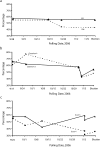Competing initiatives: a new tobacco industry strategy to oppose statewide clean indoor air ballot measures
- PMID: 19150904
- PMCID: PMC2642532
- DOI: 10.2105/AJPH.2008.138461
Competing initiatives: a new tobacco industry strategy to oppose statewide clean indoor air ballot measures
Abstract
To describe how the tobacco and gaming industries opposed clean indoor air voter initiatives in 2006, we analyzed media records and government and other publicly available documents and conducted interviews with knowledgeable individuals. In an attempt to avoid strict "smoke free" regulations pursued by health groups via voter initiatives in Arizona, Ohio, and Nevada, in 2006, the tobacco and gaming industries sponsored competing voter initiatives for alternative laws. Health groups succeeded in defeating the pro-tobacco competing initiatives because they were able to dispel confusion and create a head-to-head competition by associating each campaign with its respective backer and instructing voters to vote "no" on the pro-tobacco initiative in addition to voting "yes" on the health group initiative.
Figures


References
-
- Levy DT, Chaloupka F, Gitchell J. The effects of tobacco control policies on smoking rates: a tobacco control scorecard. J Public Health Manag Pract 2004;10:338–353 - PubMed
-
- Henson R, Medina L, St Clair S, Blanke D, Downs L, Jordan J. Clean indoor air: where, why, and how. J Law Med Ethics 2002;30:75–82 - PubMed
-
- Gilbert MD, Levine J. Less can be more: conflicting ballot proposals and the highest vote rule. The Berkeley Electronic Press. 2007. Available at: http://law.bepress.com/cgi/viewcontent.cgi?article=1975&context=alea. Accessed September 11, 2008
-
- Bowler D, Donovan T. Demanding Choices: Opinion, Voting, and Direct Democracy. Ann Arbor: University of Michigan Press; 1998
MeSH terms
Substances
Grants and funding
LinkOut - more resources
Full Text Sources
Medical

